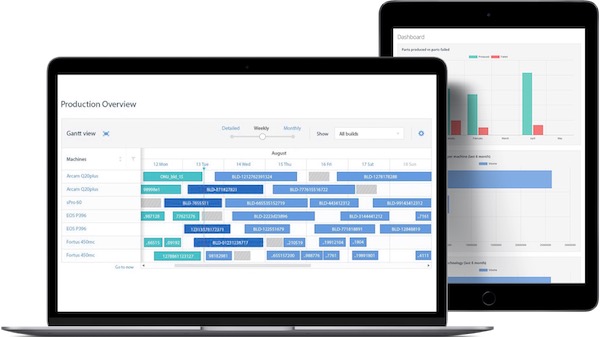AMFG Advances End-to-End AM Workflow
AMFG is partnering with LEO Lane to create automated, secure workflows for production-grade additive manufacturing.

AMFG’s end-to-end AM workflow management software helps shorten production times and reduce manufacturing costs. Image Courtesy of AMFG.
Latest News
January 14, 2019
Creating a seamless workflow and ensuring security of valuable design intellectual property (IP)—those are two major challenges slowing adoption of additive manufacturing as a primary production method and the charter of a budding partnership between AMFG Software and LEO Lane.
AMFG Software, which markets workflow automation software for AM, and LEO Lane, a maker of software that protects design IP and controls the quality of AM parts, are combining their key strengths and melding their product offerings in an attempt to address this problem. As part of their arrangement, the pair intend to integrate their software to offer a secure solution for end-to-end AM workflow management, which encompasses capabilities for virtual inventories and on-demand production.
Automate Additive Manufacturing Workflow
AMFG’s platform enables companies to create and automate an end-to-end workflow for AM jobs, including production scheduling, post-processing scheduling and file preparation. The software, which can be used with most AM technologies and 3D printers, manages everything from the initial quote process through cost estimation, specifying part properties, managing project communications status, and planning production and post-processing work.
“We handle workflows from the virtual file until the printed part leaves a company to the requesting individual,” says Felix Doerr, AMFG’s head of business development.
Unlike traditional manufacturing where one project might load up a production system for months, creating hundreds of thousands of the same part, AM runs lend themselves to individualized or small-batch series of parts, all of which are created differently even though they are produced on the same machine. Traditionally, this work is managed in a paper-based workflow or with spreadsheets, which doesn’t scale when you add more products and printers.
“A lot of traditional manufacturers start out with one printer and that’s not a problem, but as they add more printers, they’re looking not into changing their process, but thinking about how they can improve and organize themselves” and that’s where a workflow management solution fits in.
Real-Time Digital Asset Tracking
For its part, LEO Lane’s tools provide capabilities for real-time tracking of digital assets, IP protection, and controls over consistency, quality, and quantity of parts produced. Security is a critical piece of the AM puzzle, Doerr says, because the technology is still heavily used for prototyping and thus there are sensitive files with proprietary design data that must be protected.
While you can currently use the two platforms in a standalone mode, it makes more sense to combine them in an integrated fashion, according to Doerr:
“If you can lock files down or open them during specific steps, it gives customers more control over their parts. Integrating the tools enables customers to use the capabilities much more easily and establishes another level of trust that doesn’t exist today.”
The pair plan to release their first pilot of the integrated solution in the first quarter of this year with more widespread availability later in 2019. The joint solution is being developed in tandem with an industrial company, but the companies declined to name the customer.
Subscribe to our FREE magazine, FREE email newsletters or both!
Latest News
About the Author
Beth Stackpole is a contributing editor to Digital Engineering. Send e-mail about this article to [email protected].
Follow DE





